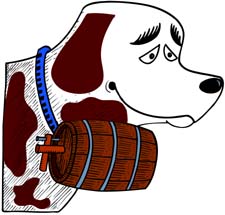 |
||
Dog First Aid--What do I need to Know?Good dog first aid boils down to just two things........1] If any type of accident does occur you need to act quickly, stay rational, and most important of all--not to panic. 2] Some problems, with a little bit of knowledge you can resolve yourself. For other problems, you will need to deal with the situation as best as you can, before contacting a nearby veterinary surgery. Your dog's health is important. Consequently, the following tips are designed to help you in this vital aspect of dog care. Cuts, abrasions, and following the removal of thorns with tweezers: Providing the injury doesn't involve a deep wound, simply snip away the fur from around the cut, with blunt-ended scissors, to expose the wound. A small cut can be cleaned with an antiseptic solution, and monitored to see if any swelling occurs--which would indicate an infection. If the cut is quite long [1/2 inch+] it will probably need stitching.You can usually stem the flow of blood from a cut by applying firm pressure to the wound for 5-10 minutes with dampened gauze or a cloth. Raising the wound from the horizontal also helps to reduce blood flow. Re-apply a new dressing if any blood seeps through. If this doesn't ease the situation--and the blood appears to be pumping out from the wound, take a large wad of cloth/gauze, apply it directly to the wound, and tie a reasonably tight bandage around the whole area. Then contact a nearby veterinary surgery. If a bite caused the cut[s] the chances are it will become infected. Clean the wound with an antiseptic solution, which you should include in your dog first aid kit. Then make an appointment to see your vet for an opinion as to whether antibiotic treatment is required. Insect stings: If visible remove the sting with a pair of tweezers. Try to avoid sqeezing the poison sac, which will force more toxin in to system. Bathe wasp stings with a vinegar solution, and bee stings with a solution of bicarbonate of soda. all other stings can be treated by cleaning the area with an antiseptic wash, and applying an antihistamine cream. A sting inside the mouth, or throat requires you to make sure that the airway is clear--pull his tongue forward if neccessary-and then contact a nearby veterinary surgery. Another beneficiary of dog first aid.
Bone, joint or tendon injuries: If a bone is broken you will usually know straight away. Cover any protruding bone with a clean cloth. Move your dog as little as possible. Don't try to attend to it yourself, make your dog as comfortable as possible--and get help straight away. Lameness, which can have a myriad of differing causes, that doesn't sort itself out quite quickly, needs a visit to your veterinarian. Poisoning: This has happened to two of my dogs, and in both cases they survived. Number 1 rule keep all poisons out of reach of your pets. Signs can be vomiting, muscular spasms, and excessive thirst--allow your dog to drink as much water as it wants. If the poison has got on to the skin wash it off. Identify what the poison was. Don't try to force your dog to vomit. Contact your vet straight away. Burns and scalds: Cool down the affected area by rinsing it with plenty of cold water. If the burn has penetrated the skin surface, do not wash it, just cover it with a clean cloth or towel, and contact your vet. Heatstroke: This should never happen to a pet that is cared for. Move the dog to an area that is cool. Decrease the dog's temperature by wrapping it in a towel that has been doused in cold water. Massage his legs to stimulate blood flow, and allow him to drink as much cool water as he wants. Choking: The tell-tale signs are pawing furiously at the mouth, retching, drooling. This needs immediate action from you, not panicking. Take a firm hold of your dog, open his mouth and see what/if anything is lodged in her throat. If you can see it and your assessment of its removal would seem easy--take it out. If not leave it. The next part is up to you, if you don't want to or feel capable of doing it, go straight to your veterinarian. Sit down, take hold of the dog's hind legs, place them between your knees so that your gripping the rear end of the dog. Placing a hand on either side of the chest, and squeeze using a motion like you would on a concertina. Doing this 5-6 times should cause the dog to cough up the object. If this doesn't happen get to your vet as quick as you can.
A good dog first aid kit includes: Tweezers, blunt nosed scissors, gauze, cotton swabs, bandage [adhesive and open weave], some squares of cotton material, a towel, antiseptic solution, antiseptic cream, and some antihistamine cream.

"
| ||
|
| Dog Health Start Page | Dog Neutering |Caring for an Older Dog |Dog Names Start Page |Dog Videos Start Page | Return to Homepage Or you can .........
|
||
|
|
||